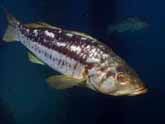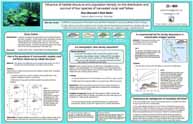|
Mark A. Steele |
||||||
|
Current Research |
||||||
|
The main goal of my research is to elucidate the causes of variation
in the abundance of organisms that live in open populations in order to understand
and predict their dynamics and spatial patterns. I place particular emphasis
on evaluating the relative importance of the various processes that determine
patterns of abundance, population dynamics, and community structure. I have
worked on reef fishes in temperate (southern California), subtropical (Gulf
of California, Mexico), and tropical (Bahamas, Caribbean, French Polynesia) systems; and also on estuarine
fishes in southern California. Currently, I have four main research
programs: (1) population dynamics and community structure of non-exploited
reef fishes; (2) density dependence in commercially-exploited reef fishes and
implications for fisheries management; (3) evaluation of artificial reefs as habitat for kelp forest fishes; (4) and
the ecology of estuarine fishes, particularly as related to wetland restoration
projects.
|
||||||
|
|
||||||
|
|
||||||
|
Population dynamics of non-exploited reef fishes |
||||||
|
My work has demonstrated that at small spatial scales, shelter
limitation and predation cause density-dependent mortality in reef fish. I have
also found that mortality in some species is density dependent at large
scales. In current collaborative work with Graham Forrester at U of Rhode
Island, I am testing whether shelter limitation is also the cause of
density-dependent mortality at large scales relevant to management by
manipulating shelter density on entire large reefs. The prediction is that
density-dependent mortality will be eliminated or weakened and population
densities enhanced on reefs with added shelter. The results will have important
implications for fisheries enhancement and conservation. I am also testing
the community level responses to shelter addition. The fieldwork is combined
with mathematical modeling (done in collaboration with Dr. Rick Vance at
UCLA) to integrate the findings of the empirical studies and predict their consequences
at even larger scales.
|
|
|||||
|
|
|
|
|
|||
|
|
||||||
|
|
||||||
|
Evaluating density dependence in harvested coral-reef fishes
|
||||||
|
Traditional fisheries management theory (e.g., maximum sustainable
yield) assumes that fish populations grow in a density-dependent fashion, whereas
current theory on MPAs typically ignores density dependence or incorporates it
in a simplistic and unrealistic way. The strength and nature (e.g., which
demographic rates it affects) of density dependence will affect how well MPAs and more traditional techiques work as tools for fisheries management. Our
work seeks to empirically evaluate the strength and nature of density dependence
in exploited coral-reef fishes.
|
|
|||||
|
|
|
|||||
|
|
||||||
|
Explorations of the population and community ecology of
estuarine fishes in southern California |
||||||
|
Over the next several years, my lab will be involved in a project evaluating the success of a large wetland restoration project in Southern California. We will evaluate whether the restored wetland has succeeded in supporting natural densities and diversity of estuarine fishes. In the course of conducting this work,
we will study the basic ecology of several estuarine fishes.
|
|
|||||
|
|
|
|
|
|||
| Reproduction of kelp forest fishes on a large artificial reef
|
||||||
| To mitigate the effects of the cooling system for the San Onofre Nuclear Generating Station (SONGS) on a nearby kelp forest, Southern California Edison is building a large (150 acres) artificial reef off the coast of San Celemente, California. For this mitigation to be successful, this artificial reef must function like a natural reef. In collaboration with colleagues at UC Santa Barbara, my lab will be evaluating whether fishes living on the artificial reef reproduce at rates similar to those of fishes living on nearby natural reefs. |  |
|||||









